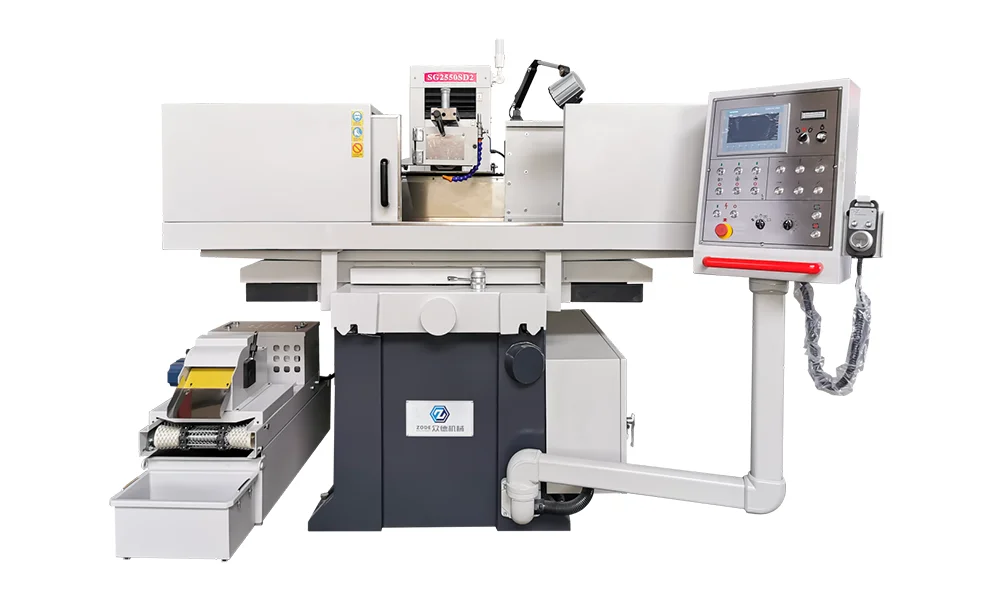In modern manufacturing and precision engineering, the need for higher precision, higher operating efficiency and higher automation has driven surface grinding technology into a new era. Designed to simplify grinding operations, improve repeatability and reduce manual intervention, 2-axis PLC (Programmable Logic Controller) automatic surface grinders have become indispensable equipment in tool rooms, production workshops and high-precision component manufacturing. In this blog post, Nantong Zode, a high quality automatic surface grinding machine exporter, will share the performance advantages of 2 axis PLC automatic surface grinder for sale.
2 Axis PLC Automatic Surface Grinder Performance Advantages
1. Enhanced Precision and Repeatability
One of the core performance advantages of a 2 Axis PLC surface grinder lies in its ability to deliver exceptional precision and repeatability. In conventional surface grinders, operator skill plays a significant role in determining output quality. However, with PLC control over the X (longitudinal table movement) and Z (crossfeed or wheel feed) axes, motion becomes highly consistent and predictable.
- Linear Encoder Integration: Many high-end 2 Axis systems incorporate linear encoders that feed real-time positional data back to the PLC. This closed-loop feedback system ensures micron-level positional accuracy.
- Consistent Depth of Cut: With programmable depth control, each pass removes exactly the specified material, eliminating human error in manual dial adjustments.
- Repetitive Cycle Accuracy: For batch production, once a grinding program is set, it can be repeated indefinitely with negligible variance between workpieces.
This precision is vital in applications such as die and mold making, gauge block grinding, and flatness-critical aerospace or medical components.
2. Productivity and Time Efficiency
Surface grinding is traditionally labor-intensive. The transition to 2 Axis PLC automation dramatically improves cycle time efficiency while minimizing human involvement.
- Simultaneous Axis Control: The PLC can control both the table (X-axis) and the crossfeed/wheel feed (Z-axis) simultaneously, allowing for complex grinding patterns and adaptive motion sequences.
- Cycle Programming: Operators can pre-program entire grinding cycles—including spark-out passes, dwell times, incremental feeds, and return-to-home functions. This drastically reduces downtime between tasks.
- Auto Retract and Park Functions: At the end of a cycle, the machine can automatically retract the wheel and park the table, enabling quick part changeover and safer handling.
The net result is a shortened production cycle, higher throughput, and reduced operator fatigue or error.
3. Superior Surface Finish Quality
Surface finish is a crucial parameter in grinding operations. Inconsistencies in feed rates, dwell times, or wheel positioning can degrade surface integrity. The PLC's control logic allows for refined and consistent motion profiles, which directly improve surface finish.
- Adjustable Feed Rates: Fine-tuned feed rates at each stage ensure optimal material removal without chatter or burn marks.
- Spark-Out Passes: PLC-controlled spark-out cycles, where the grinding wheel continues to pass without feeding, remove any residual high spots, resulting in a mirror-like finish.
- Wheel Wear Compensation: Some systems include wheel wear compensation routines, which maintain consistent grinding pressure even as the abrasive wheel wears down.
Together, these capabilities enable production of parts with surface roughness values as low as Ra 0.2 µm, critical for components in sealing surfaces, optical mounts, or hydraulic systems.

4. Operator Safety and Ease of Use
Traditional grinders demand constant attention, which can expose operators to rotating wheels, flying debris, and ergonomic strain. 2 Axis PLC systems incorporate multiple safety and convenience features.
- Automatic Operation: Once a program is loaded and a part is secured, the machine operates without further input until the cycle ends.
- Integrated Safety Interlocks: Many systems include door interlocks, emergency stops, and overload protection to mitigate hazards.
- User-Friendly HMI (Human-Machine Interface): Touchscreen panels allow intuitive program entry, diagnostics, and parameter adjustment, reducing training requirements and operator error.
The PLC architecture also supports remote diagnostics and maintenance logging, further improving operational oversight.
5. Flexibility and Adaptability
Modern production environments require machines that can handle a variety of parts with minimal setup changes. 2 Axis PLC surface grinders excel in adaptability:
- Customizable Programs: Operators can store and recall numerous grinding recipes for different part geometries and material types.
- Sub-Routines for Complex Patterns: Advanced PLCs can execute subroutines, such as step-over grinding, taper correction, and multiple-point wheel dressing.
- Retrofitting and Integration: These grinders can be easily integrated into existing production lines or upgraded with automation peripherals like robotic loaders or in-line inspection systems.
This flexibility allows manufacturers to rapidly switch between prototypes and production runs with minimal reconfiguration.
6. Reduced Skill Dependency
As experienced machinists retire and skilled labor shortages grow, automated solutions help bridge the gap. The learning curve for operating a 2 Axis PLC grinder is significantly lower than mastering manual grinding techniques.
- Preloaded Macros: Basic operations like rough grinding, fine grinding, and dressing can be initiated using preconfigured macros.
- Step-by-Step Setup Guidance: The HMI often includes setup wizards, diagnostic prompts, and visual guides.
- Training Efficiency: New operators can be trained in days rather than months, ensuring faster workforce deployment.
This lowers the barrier to entry and standardizes performance across shifts or facilities.
Conclusion
The 2 Axis PLC automatic surface grinder represents a powerful fusion of mechanical robustness and intelligent control. Its precision, efficiency, flexibility, and safety characteristics make it an invaluable asset for operations demanding high-tolerance grinding with minimal operator intervention.
From small batch tool rooms to high-volume production facilities, the implementation of these machines leads to enhanced throughput, superior surface finishes, reduced labor dependency, and higher overall profitability. As manufacturing evolves, 2 Axis PLC surface grinders will continue to play a pivotal role in delivering the precision and consistency modern industries require.
www.zodemc.com
Nantong Zode